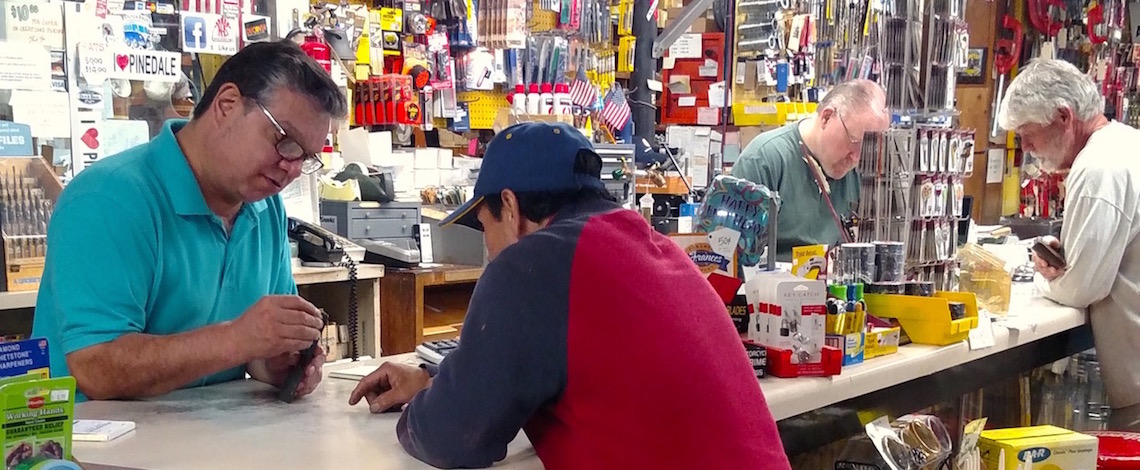
Photo courtesy of Lisa Guzman. Jesse Settle, manager at National Hardware, gauges wire for a customer among row after row of inventory.
Written by
Despite dips in home prices, the construction sector still represents a massive portion of U.S. GDP. According to the latest Census Bureau data, valuation of the residential construction sector has seen an 11 percent increase from August of 2016 to August of 2017.
That means a lot more money filtering into the numerous hardware stores across the Valley.
The problem for small businesses, however, is grabbing a share of that market whose big-box competitors have seen significant growth and stock performance.
Hardware retailers who have relied on old blood for knowledgeability and customer service now have to reevaluate and look to new methods for efficiency and broader market access through unique offerings and the ever-expanding internet of things (IoT).
As the sector becomes modernized, stores across the Valley fight to maintain relevance and draw in customers, whether its mimicking services or utilizing 21st century technology to squeeze every penny into increasing that bottom line.
Distinguishable customer service
Whether 2017 or 1977, the basics to any hardware retail store are distinguishing oneself from the competition. Baby boomers might know what they’re looking for when they step foot into a hardware store, but when it comes to the up-and-coming Millennial generation, the problem is a bit more than just another turn of the screw.
“What I find is that even close friends of mine don’t know a wrench versus a screwdriver,” said Ian Williams, 27, store manager of operations at Fresno Ag Hardware.
This might seem a little unbelievable, but even Home Depot posted a video on YouTube about how to use a measuring tape.
Instead of seeing this as an obstacle, though, many small-business owners see this as an opportunity.
Williams calls it “building a customer.”
When one tours the Yelp reviews of many small businesses, one can see the vast number of reviews praising the stores’ ability to solve problems and get customers what they need, from beginning to end.
Lisa Guzman, owner of National Hardware in Fresno, has invested in personnel specifically geared to capture and bring in young people.
A new social media director at her store, which has been open for almost 60 years, is working on releasing how-to videos for things like toilet repair.
The store, located right across the street from Home Depot, also employs two engineers to ensure that whatever problem brought that customer into the store, that they would be able to get them an answer.
Williams looks at his younger generation as two different populations — those who want to try something on their own and those who want someone else to do it.
“People may not know how to wire a 3-pronged socket or install a faucet. What we believe we are doing with those customers is we are building a customer.”
Knowing the right tools
Building the customer is one thing, but finding them and bringing them into the store is the first step to guaranteeing the store’s future.
Expanding a customer base seems intuitive, but is easier said than done.
One way to do so is by staying competitive price-wise.
The Ace Hardware cooperative between stores allows business owners to provide volume pricing to small-business owners, and within the past few years, 12 companies have come under the Ace umbrella.
“With a franchise, you don’t get to own your business, you don’t get to decide how it runs,” Williams said. “Whereas with a co-op, you own part of that business.”
Ace purchases goods for its member-businesses at volume prices, much like big-box stores can, and so the smaller businesses can stay competitive.
Contractor and commercial sales, however, are still the bread and butter of any hardware store. Contractors don’t have time to wait for orders online and Guzman knows this.
But she took it one step further.
She began by reaching out to businesses near her and establishing delivery routes through a new outside sales person. Small business means a small staff, and so, in her eyes, those businesses don’t always have the time to run out and replenish everyday supplies.
What Guzman is hoping to offer to set her apart is a faster, more convenient alternative to even online ordering.
Operations with a 2017 approach
In hardware stores, behind the employee-only doors is a treasure trove of inventory that brings their customers in.
At Fresno Ag, Williams says he keeps upwards of 120,000 individual items in stock. 70,000 of which sell on a pretty regular basis.
More and more, software developers have learned to provide retailers with capabilities that provide owners and managers with modern tools to track how goods are bought and sold — the kinds of tools many hardware stores aren’t putting to good use.
Over at National Hardware, Guzman still relies on experience to know what’s selling.
She knows to anticipate when students are finishing certification programs so they can have enough of the things she knows will sell — things like tool bags.
Kirk Tanner, chief communications officer at Fishbowl Inventory, an inventory management software company based in Utah, says that new developments in software can do that and so much more.
“Internet of things” — web connectivity of various objects — integrates live reporting throughout a store’s inventory guns, cash registers and even synchronizes different websites companies might be selling to, keeping correct and up-to-date counts across every channel a company uses to sell.
This means that customers can see online whether or not the store has a certain item in stock, bringing them into the store.
This also means software can do what it used to take working hours to do.
The companies Tanner works with employ on average around eight people, and he touts the ability of modern software to cut labor costs by up to 16 hours a day.
Streamlining processes can take people out of the warehouse and onto the sales floor.
“The way I’m seeing it is I’m helping a department.” Williams said. “I’m taking a job that used to take three hours to do and I’m making it into a 30-minute job.”
For a company that relies on being in the aisles to meet customers, that means greater profit potential.








